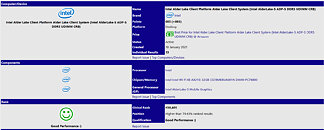Jul 24th, 2025 04:34 CDT
change timezone
Latest GPU Drivers
New Forum Posts
- The Official Magic the Gathering card game Rules, Questions, and General Discussion Thread (270)
- Herman Miller Logitech G Embody Gaming Chair (1)
- 420 radiator size?? (5)
- R9 7900X - 5070Ti - Lags / Stuttering (5)
- RX 9000 series GPU Owners Club (1185)
- Need some help finding correct VBIOS for my RX580 (7)
- Metro Last Light: can't set any resolution above 2804x1577 (45)
- 14900k high voltage (40)
- What are you playing? (24000)
- Will you buy a RTX 5090? (655)
Popular Reviews
- Noctua NF-A12x25 G2 PWM Fan Review
- MSI MPG B850I Edge Ti Wi-Fi Review
- Cougar OmnyX Review
- Thermal Grizzly WireView Pro Review
- TerraMaster F4-424 Max Review - The fastest NAS we've tested so far
- UPERFECT UMax 24 Review
- Razer Blade 16 (2025) Review - Thin, Light, Punchy, and Efficient
- Upcoming Hardware Launches 2025 (Updated May 2025)
- Sharkoon OfficePal C10 Review - Affordable and Decent
- Sapphire Radeon RX 9060 XT Pulse OC 16 GB Review - An Excellent Choice
TPU on YouTube
Controversial News Posts
- Some Intel Nova Lake CPUs Rumored to Challenge AMD's 3D V-Cache in Desktop Gaming (140)
- AMD Radeon RX 9070 XT Gains 9% Performance at 1440p with Latest Driver, Beats RTX 5070 Ti (131)
- NVIDIA Launches GeForce RTX 5050 for Desktops and Laptops, Starts at $249 (127)
- NVIDIA GeForce RTX 5080 SUPER Could Feature 24 GB Memory, Increased Power Limits (115)
- AMD's Upcoming UDNA / RDNA 5 GPU Could Feature 96 CUs and 384-bit Memory Bus (113)
- NVIDIA DLSS Transformer Cuts VRAM Usage by 20% (99)
- AMD Sampling Next-Gen Ryzen Desktop "Medusa Ridge," Sees Incremental IPC Upgrade, New cIOD (97)
- NVIDIA Becomes First Company Ever to Hit $4 Trillion Market-Cap (94)
Tuesday, January 19th 2021

16-Core Intel Alder Lake-S Processor Appears with DDR5 Memory
Intel has just launched its Rocket Lake-S desktop lineup of processors during this year's CES 2021 virtual event. However, the company is under constant pressure from the competition and it seems like it will not stop with that launch for this year. Today, thanks to the popular leaker @momomo_us on Twitter, we have the first SiSoftware entries made from the anonymous Alder Lake-S system. Dubbed a heterogeneous architecture, Alder Lake is supposed to be Intel's first desktop attempt at making big.LITTLE style of processors for general consumers. It is supposed to feature Intel 10 nm Golden Cove CPU "big" cores & Gracemont "small" CPU cores.
The SiSoftware database entry showcases a prototype system that has 16 cores and 32 threads running at the base frequency of 1.8 GHz and a boost speed of 4 GHz. There is 12.5 MB of L2 cache (split into 10 pairs of 1.25 MB) and 30 MB of level-three (L3) cache present on the processor. There is also an Alder Lake-S mobile graphics controller that runs at 1.5 GHz. Intel Xe gen 12.2 graphics is responsible for the video output. When it comes to memory, Alder Lake-S is finally bringing the newest DDR5 standard with a new motherboard chipset and socket called LGA 1700.
Sources:
SiSoftware, via @momomo_us (Twitter)
The SiSoftware database entry showcases a prototype system that has 16 cores and 32 threads running at the base frequency of 1.8 GHz and a boost speed of 4 GHz. There is 12.5 MB of L2 cache (split into 10 pairs of 1.25 MB) and 30 MB of level-three (L3) cache present on the processor. There is also an Alder Lake-S mobile graphics controller that runs at 1.5 GHz. Intel Xe gen 12.2 graphics is responsible for the video output. When it comes to memory, Alder Lake-S is finally bringing the newest DDR5 standard with a new motherboard chipset and socket called LGA 1700.
Jul 24th, 2025 04:34 CDT
change timezone
Latest GPU Drivers
New Forum Posts
- The Official Magic the Gathering card game Rules, Questions, and General Discussion Thread (270)
- Herman Miller Logitech G Embody Gaming Chair (1)
- 420 radiator size?? (5)
- R9 7900X - 5070Ti - Lags / Stuttering (5)
- RX 9000 series GPU Owners Club (1185)
- Need some help finding correct VBIOS for my RX580 (7)
- Metro Last Light: can't set any resolution above 2804x1577 (45)
- 14900k high voltage (40)
- What are you playing? (24000)
- Will you buy a RTX 5090? (655)
Popular Reviews
- Noctua NF-A12x25 G2 PWM Fan Review
- MSI MPG B850I Edge Ti Wi-Fi Review
- Cougar OmnyX Review
- Thermal Grizzly WireView Pro Review
- TerraMaster F4-424 Max Review - The fastest NAS we've tested so far
- UPERFECT UMax 24 Review
- Razer Blade 16 (2025) Review - Thin, Light, Punchy, and Efficient
- Upcoming Hardware Launches 2025 (Updated May 2025)
- Sharkoon OfficePal C10 Review - Affordable and Decent
- Sapphire Radeon RX 9060 XT Pulse OC 16 GB Review - An Excellent Choice
TPU on YouTube
Controversial News Posts
- Some Intel Nova Lake CPUs Rumored to Challenge AMD's 3D V-Cache in Desktop Gaming (140)
- AMD Radeon RX 9070 XT Gains 9% Performance at 1440p with Latest Driver, Beats RTX 5070 Ti (131)
- NVIDIA Launches GeForce RTX 5050 for Desktops and Laptops, Starts at $249 (127)
- NVIDIA GeForce RTX 5080 SUPER Could Feature 24 GB Memory, Increased Power Limits (115)
- AMD's Upcoming UDNA / RDNA 5 GPU Could Feature 96 CUs and 384-bit Memory Bus (113)
- NVIDIA DLSS Transformer Cuts VRAM Usage by 20% (99)
- AMD Sampling Next-Gen Ryzen Desktop "Medusa Ridge," Sees Incremental IPC Upgrade, New cIOD (97)
- NVIDIA Becomes First Company Ever to Hit $4 Trillion Market-Cap (94)

29 Comments on 16-Core Intel Alder Lake-S Processor Appears with DDR5 Memory
So GoldenCove is basically TigerLakes Core, wich is 10nm SuperFin but by now tops out at 4 Cores.
So AlderLake comes with the Combination of newer than RocketLake big Cores plus newer than Tremont little Cores.
Will be a composition of upto 8 big SMT-Cores (each 1.25MB L2 and 3MB L3) paired with two 4-Core Clusters (each 1.25MB L2 and 3MB L3) of Gracemont Atoms wich lack SMT,
leading to 12.5MB L2 and 30MB L3, 8 Core-Threads + 8 SMT-Threads from the big cores and 8 Core-Threads from the 2 Quadcore Atom-Clusters ... so 24 Threads in Total.
There will be also Variants without activated Atom-Clusters, wich are quite similar to RocketLake 8-Cores plus SMT, but upgraded to 10nm SuperFin and Tigerlake aka GoldenCove technic.
Because of implementation issues, also regarding Microfoft Windows, the big Cores SMT and AVX needed to be permanently deactivated from factory. AlderLake and some newer Windows-Versions should have fixed these culpits.
like 2 big Cores plus both full Quad-Core Atom Clusters
Additionally i think actually a bunch of the competitive Games have a clear limit at 1 to 3 heavy Threads in Games, the rest of the Threads could be easily run on Atom-style Cores in my opinion.
/s
Binning cuts into profits so they use crappy chips and boom now all they have to do is hype and sell it as by design.
Meanwhile, almost everyone else who is anyone in the tech world is moving full speed ahead onto 7/5/3/2nm nodes....
Also why are clock & boost speeds going backwards... yea I kno... heat, TDP yada yada yada
Good to see DDR5 mentioned though, so there's that !
In fact, it's a rather clever approach as long as there is enough fast cores for more common lightly-threaded tasks.
The definition of the 10nm on Intel Fabs is different from the definition used at TSMC, they use to be similar back around 22nm but now it's all gibberish.
Better to look at transistor density - basically intel 10nm is as dense as TSMC 7nm.
They seem to be working on something related to it.
Then everyone can see how many heavy taxing softwarethreads every game really needs.